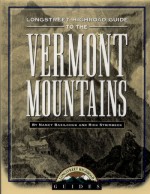 The Longstreet Highroad
Guide to the Vermont Mountains
The Longstreet Highroad
Guide to the Vermont Mountains[home][articles I’ve written][contact me]
 The Longstreet Highroad
Guide to the Vermont Mountains
The Longstreet Highroad
Guide to the Vermont Mountains
Chapter 1, the Natural History of Vermont’s Mountains
How we wrote the book
It started, as many things do, with a phone call.
Longstreet Press, the publishing arm of the Cox newspaper chains, had launched a series of natural history guides in 1997 after the unexpected success of a guide written by the Georgia Nature Conservancy. I was a natural candidate to write such a guide, since I was the environmental writer for Vermont's largest newspaper. When publishing executive Marge McDonald called to recruit me, it didn't take long for me to answer yes.
Thus began a frenzied year of fieldwork and writing. Longstreet agreed that my husband and fellow naturalist Rick Strimbeck would be a great addition to the writing team, and gave us a deadline of Dec. 1998 to finish a 120,000-word book. Trouble was, we both had full-time jobs and two daughters: an 8-year-old and a 4-year-old. But with the help of my parents, who took the girls for some long vacation weeks, and a trusty babysitter named Chelsea Martin, who watched the girls every Sunday morning for four hours, we managed. But I think it’s safe to say we didn’t sleep much that year.
The Longstreet guides are unusual as natural history guides because they are site-specific. You read about Camel's Hump, for example, and our guidebook tells you about the land use history, the plants and animals you’ll see as you climb the mountain, and you get a full description of the trail network and how to access it.
We spent the early winter of 1998 planning our assault on the Green Mountain State. I’d lived in Vermont since 1984, Rick since 1985, but much of our birdwatching and botanizing was limited to the northern half of our long, skinny state. We planned accordingly. In the spring of 1998 we wrote the chapters for the places we knew intimately, saving the summer of ’98 for field work in southern Vermont. Santa Claus contributed to this effort by giving us a full-sized Therm-a-Rest double sleeping pad as a Christmas present, so we would be able to go car-camping in comfort.
If I had to summarize the whole experience I could do it with one word: Fun. For years Rick and I had wandered the Vermont woods, mentally tabulating lists of interesting physical phenomena, beautiful natural spots, and cool places to see evidence of Vermont’s fascinating geologic past. The guidebook gave us an audience for all this accumulated knowledge. After all, where else can you usefully and profitably report the location of Vermont’s highest-elevation glacial pothole, or the reason why there are stands of Norway spruce, a non-native tree, growing in great clumps on the side of Camel's Hump. And who else but a guidebook publisher is going to pay you to spend a summer hiking the Green Mountains and taking notes? (OK, OK, I did manage to convince someone else to pay me to spend a good part of one summer hiking and writing about it: in 1996,as The Burlington Free Press's environmental writer, I hiked about 80 miles of Vermont’s end-to-end hiking trail, the Long Trail, and wrote a series of articles about the experience. In addition to being fun to write, my pieces won the Outstanding Writer of the Year Award from Gannett, the Free Press’s owner and the nation’s largest newspaper chain.)
We think the result of our year’s worth of work, published in April, 1999, is a great way for visitors and year-round residents to gain a unique view of the Green Mountain State while wandering the hills. We hope you’ll agree.
Buy The Longstreet Highroad Guide to the Vermont Mountains.